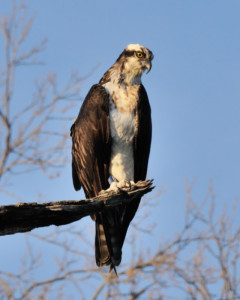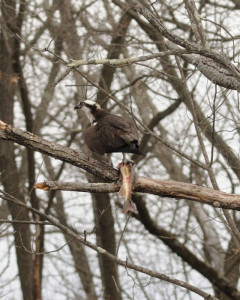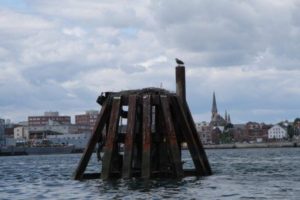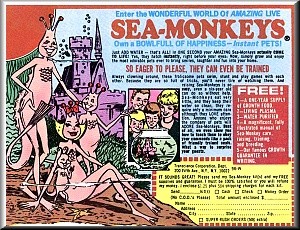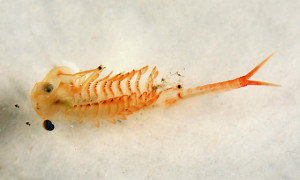Month: April 2016
Shadow of the Osprey
Article and photos by Joe Mish
The osprey from Maine searches the clear water of the South Branch for a meal as she takes a break from her 2,500 mile journey north. The letters, DV, can be seen on the blue band attached to her right leg.
The warmth from the mid-morning sun felt good on my back as I paddled the low, clear water of the South Branch. The cloudless sky, directly above, was a darker shade of blue, its intensity pure and endless, and mesmerizing. It compelled me, as the devil’s advocate, to search for just a single speck to interrupt its perfection.
Suddenly a shadow sped across the water, momentarily stealing the sunlight. I instinctively looked up to catch a glimpse of an osprey circling above. The white head, streaked with a dark brown stripe, was instantly recognizable. The osprey proceeded downriver by making tight overlapping circles in its search for fish. It isn’t too hard to imagine some of these super intelligent predators realize a canoe is herding the fish ahead of it. When the osprey was about 150 yards downstream it tucked its wings and dove into foot deep water to come up with a large white sucker held fast in its black talons. The bird oriented the position of the fish to cut wind resistance as it flew out of sight.
Ospreys are ever present on the South Branch, typically from early spring to mid autumn. They feed primarily on live fish. I see them most often eating white suckers, a fish large enough to compensate for the energy spent to catch it.
Osprey on a riverside perch, dining on fresh fish during the 2014 NJ opening day of trout season.
Earlier this April, I noticed an osprey perched in the same location day after day. This wasn’t typical of the local ospreys that ranged far and wide in their constant search for food. I was able to get a few photos and noticed a blue band on the right leg and a silver band on the left. I reported the band to the USGS website, BandReports@usgs.gov, to find this osprey was banded in Portland, Maine, July 27th, 2011 while it was still in the nest, too young to fly.
Osprey migrate from the northeast, where they breed, to central and South America each fall, a trip of more than 2,500 miles. This bird was apparently on its way back to Maine and stopped to rest. Osprey, like other migratory birds, are very loyal to nest sites and return to the same location with great predictability.
Consider our visiting osprey will be 5 years old this July, and has 25,000 plus, frequent flyer miles on its account, you have to recoil in amazement, wonder and respect for its strength and tenacity. As osprey can live 25 to 30 years or more, the mileage really adds up.
Our Maine visitor, a female, as evidenced by her speckled décolletage, has a bright and long future and hopefully will stop along the South Branch again on her journey to and from Central America. No doubt other osprey are flying to northern breeding grounds through NJ, so the opportunity to spot a banded bird along the North and South Branch are quite good.
The reporting of banded birds is critical to wildlife research as it helps to unravel the mystery of migration, the location of breeding grounds, longevity, and other variables that impact the health and status of local and overall wildlife populations.
New Jersey is now using red bands for osprey and from Ben Wurst at conservewildlifenj.org, as per USGS; “Green anodized bands are being used in NY. Purple anodized bands in MD and VA. Red anodized bands (like ours, but with alpha code A&B 00-99) in PA (permit is expired now). Blue anodized bands in MA, ME & Ontario.”
The preponderance of osprey nests in NJ are along the Delaware River and Atlantic shoreline, its estuaries, bays and rivers, so keep an eye out for banded birds and report them to BandReports@usgs.gov . The researchers are as excited about a band report as you and will send a certificate of appreciation with relevant data about your bird. Many species of birds are banded, so don’t forget our eagles, hawks and songbirds. Opportunities abound as NJ is on a major flyway, the rivers being main exit and entrance ramps to our backyard.
*Joe sent us an update to this post, a photo of the exact location in Maine where the osprey was born. Photo courtesy of Lauren Gilpatrick at the Biodiversity Research Institute, Portland Maine.
See, http://www.conservewildlifenj.org/education/ospreycam/ for more details about NJ osprey project and live osprey cam.
Special thanks to Robert Somes, Kathy Clark and Ben Wurst for their enthusiastic help and support.
Robert Somes, Senior Zoologist
NJ Division of Fish and Wildlife
Endangered and Nongame Species Program
Kathy Clark,CWB,
NJ Division of Fish and Wildlife
Endangered and Nongame Species Program,
Ben Wurst, Habitat Program Manager
New Jersey Osprey Project
Author Joe Mish has been running wild in New Jersey since childhood when he found ways to escape his mother’s watchful eyes. He continues to trek the swamps, rivers and thickets seeking to share, with the residents and visitors, all of the state’s natural beauty hidden within full view. To read more of his writing and view more of his gorgeous photographs visit Winter Bear Rising, his wordpress blog. Joe’s series “Nature on the Raritan, Hidden in Plain View” runs monthly as part of the LRWP “Voices of the Watershed” series. Writing and photos used with permission from the author.
National Sea Monkey Day (May 16) is Reason to Celebrate New Jersey’s Vernal Ponds
By: Heather Fenyk
Part of the fun of reading comic books when I was a kid was coming across ads for the absurd: Monster Size Monsters! X-Ray Vision Glasses! Kung-fu Sandals! (AUTHENTIC! Worn for Centuries by Oriental Fighting Masters!) But my absolute favorite adverts included invitations to “Own A Bowl Full of Happiness.” For just 49¢ plus $2.99 shipping, you could raise your own “trainable” insta-pet, the Sea Monkey.
Sea-Monkey ad from 1970’s comic book
Sea Monkeys fall into a general group of organisms including brine shrimp and “fairy shrimp” that, with the proper mix of nutrients and chemicals, can be stored in dry form and then “revived” with a dose of plain tap water.
Recent rains have nourished our New Jersey swamps and freshwater marshes, transforming seeming terra firma into vernal or ephemeral ponds. These ponds – or more specifically their “fairy shrimp” inhabitants – get me out in the field looking for Sea Monkeys.
The descriptive terms for these freshwater wetland types — “vernal” and “ephemeral” — refers to their habit of appearing in spring and being short-lived or temporary. Many vernal ponds in New Jersey and elsewhere were not protected during the post-World War II building boom. But with the passage of the New Jersey Freshwater Wetlands Protection Action in 1987, all freshwater wetlands – including these temporary wetlands – were finally granted protection. Fairy shrimp benefit directly from these protection measures.
A common species of fairy shrimp in our New Jersey vernal ponds is Eubranchipus vernalis. It grows between 0.5 and 1.5 inches in length, and other than its forked tail and large, stalked, compound eyes, its most obvious features are the 11 pairs of feathery appendages it uses for swimming, breathing and feeding. It collects algae, bacteria, protozoa, rotifers, and detritus on the feather-like structures and transfers that material to its mouth by other appendages. In addition, it will scavenge dead tadpoles, mollusks and amphibian eggs.
Eubranchipus vernalis. Image from www.bugguide.net
The shrimp’s reproductive strategy is fascinating. After mating, the male dies. The females are easily distinguished from males by the egg-filled brood sac on their abdomen, and the sac contains one of two types of fertilized eggs depending on the density of males in the pond. A low density of males results in thin-shelled “summer eggs,” which have a very short incubation period and hatch inside the brood sac. A high density of males results in thick-shelled “winter eggs” that eventually fall to the bottom of the pond and remain there even when the pond dries out. They will hatch the following spring, when the pond refills, and they have an amazing capacity to withstand extreme elements, including temperatures that are probably never encountered in nature: from a high of just below boiling (210 degrees) to a low extreme of -310 degrees.
The powdered thick-walled eggs of fairy shrimp are the type that my sister Julie purchased in 1978 from the back of an Archie Comic Book. It is this egg stage that enables the fairy shrimp to be distributed to other potential vernal ponds. Fairy shrimp eggs are tiny, dry granules that can be blown by the wind or picked up on the feet of animals and carried to other vernal ponds. These thick-walled, dry eggs remain viable even after 15 years, and the eggs are supposed to hatch 30 hours after being submerged in water.
Sadly, Julie’s order of Sea Monkeys never hatched. While she was perhaps permanently scarred by being duped into purchasing a package of powdered brine shrimp, I remain suckered in by the advertising and happily spend spring weekends exploring New Jersey’s vernal pools looking for my own Sea Monkeys to train.
Happy National Sea Monkey Day!

